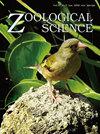水通道蛋白7和9与db/db小鼠肥胖和脂肪肝的关系
IF 0.9
4区 生物学
Q3 ZOOLOGY
引用次数: 0
摘要
本文章由计算机程序翻译,如有差异,请以英文原文为准。
Association of Aquaporin 7 and 9 with Obesity and Fatty Liver in db/db Mice
Aquaporin (AQP) 7 and AQP9 are membrane channel proteins called aquaglyceroporins and are related to glucose and lipid metabolism. AQP7 is mainly expressed in white adipose tissue (WAT) and is involved in releasing glycerol into the bloodstream. AQP9 is the glycerol channel in the liver that supplies glycerol to the hepatic cells. In this study, we investigated the relationship between the expression of aquaglyceroporins and lifestyle-related diseases, such as obesity and fatty liver, using 22-week-old db/db mice. Body weight, WAT, and liver weight showed increases in db/db mice. The levels of liver lipids, plasma lipids, insulin, and leptin were also increased in db/db mice. Gene expression related to fatty acid and triglyceride synthesis in the liver was enhanced in db/db mice. In addition, gene and protein expression of gluconeogenesis-related enzymes was increased. Conversely, lipolysis-related gene expression in WAT was reduced. In the db/db mice, AQP9 expression in the liver was raised; however, AQP7 expression in WAT was reduced. These results suggest that in db/db mice, enhanced hepatic AQP9 expression increased the supply of glycerol to the liver and induced fatty liver and hyperglycemia. Additionally, reduced AQP7 expression in WAT is associated with excessive lipid accumulation in adipocytes. Aquaglyceroporins are essential molecules for glucose and lipid metabolism, and may be potential target molecules for the treatment of obesity and lifestyle-related diseases.
求助全文
通过发布文献求助,成功后即可免费获取论文全文。
去求助
来源期刊

Zoological Science
生物-动物学
CiteScore
1.70
自引率
11.10%
发文量
59
审稿时长
1 months
期刊介绍:
Zoological Science is published by the Zoological Society of Japan and devoted to publication of original articles, reviews and editorials that cover the broad field of zoology. The journal was founded in 1984 as a result of the consolidation of Zoological Magazine (1888–1983) and Annotationes Zoologicae Japonenses (1897–1983), the former official journals of the Zoological Society of Japan. Each annual volume consists of six regular issues, one every two months.
 求助内容:
求助内容: 应助结果提醒方式:
应助结果提醒方式:


